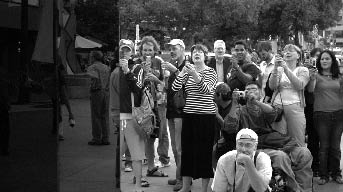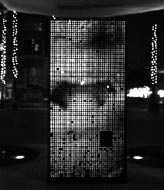Unseen Architecture
by Albert Chao

SEEN, at first glance, is plain and unmarked. A visually deceptive installation by architect Omar Khan, this art piece seems nothing but a four-foot-by-eight-foot blank slate. Nevertheless, crowds, with digital cameras and cell phones in hand, still form around the piece.
A part of the 13th International Symposium of Electronic Art in August 2006, SEEN—an acronym for “screens exposing employed narratives”—is both about how you look and where you look.
How: The blank slate is in actuality emitting infrared light that is invisible to the naked eye. To see, one looks through the lenses of digital imaging devices, including camera phones, digital cameras and digital camcorders capable of detecting infrared rays.
Where: Without the camera, the space appears devoid of anything. The camera, however, becomes a tool that brings the digital world into the real. The images were compiled from responses to a question—What is the fruit of your labor?—that was asked to three labor communities in San Jose: Silicon Valley’s tech workers, undocumented service workers and outsourced call center workers.
Khan, also an assistant professor of architecture at the University at Buffalo, explores different potentials with what he defines as “situated technologies.” Khan, along with Mark Shepard, assistant professor of architecture and media studies, and Shahin Vassigh, associate professor of architecture, direct the Center for Virtual Architecture, a research facility that investigates the intersection between virtual and real. Their work develops unique architectural approaches to an environment that is saturated with digital technologies.
Like Khan’s installations exploring the visual, Shepard’s Tactical Sound Gardens (TSG) engages the digital audio environment. Using mobile devices, including laptops, PDAs and cell phones, participants cultivate public “sound gardens” by planting or pruning (manipulating) sounds within wireless (WiFi) “hot zones.” The position of the mobile devices is triangulated through WiFi signals. Audio listeners don a pair of headphones connected to their mobile device to experience the sound garden.
Sound gardens can only proliferate within the overlap of digital and real space, as Shepard describes: “It is a parasitic technology, in the fact that it feeds off wireless networks of dense urban settings.” Shepard uses this particular space for public interaction in response to the iPod, a personal device that potentially isolates individuals from their surroundings, as Shepard explains: “With the iPod, you have a certain degree of control over your surroundings. The device becomes a tool for controlling space, time and the boundaries around the body in urban public space.” Sound gardens, in contrast to the iPod, reconnect people by providing a platform for social interaction within these hybrid spaces.

In addition to audio and visual environments, Shahin Vassigh researches learning environments. Khan, who has collaborated with Vassigh, points out that architecture is no longer limited to buildings: “Whether in a business class or an architecture studio, we are interested in and have the tools to engage all different environments.” One project began with Vassigh and Khan collaborating with Lida Radfar, a former professor at the School of Dentistry at the University at Buffalo. The site was the temporomandibular joint (TMJ), a particularly difficult topic to teach because of its complex movements in three different directions. Vassigh and Khan modeled the human skull and jaw on the computer and then simulated the motions and movements of the TMJ. Through digital technologies, a virtual model becomes a tool for real life practice.
Vassigh has also pursued digital technology in the education of architects, specifically in integrating building structures principles, normally associated with engineering, with architecture studio class. She directed a 2001 funded project to create a digital interactive software that integrates structural concepts with architectural practice. Her latest project, a grant award of $553,045 funded by the US Department of Education, continues her prior research, as she explains: “The project will develop a ‘game’ that simulates the real world of architectural practice. By introducing the technology content in a gaming environment, students are faced with a series of scenarios and decision making options awaiting their response. Instantaneous feed back from the game will enable them to understand the implication of their choices in relation to all other decisions involved in the design process, allowing them to adjust their design accordingly.” In addition to structural concepts, the software will also integrate new technologies and practices of sustainability that are essential to contemporary practice.
Traditional notions of site in architecture have broken down through the work and research of Omar Khan, Mark Shepard and Shahin Vassigh. They have explored contemporary issues of space and reinvented new applications of digital technology. The digital world creates new possibilities for the digital world to affect reality, as Shepard contemplates: “The built environment is no longer a given or a set construct. Ubiquitous technologies create infrastructure that brings a different engagement with space, and with that new possibilities.”
Shepard’s Tactical Sound Garden Toolkit (tacticalsoundgarden.net) is currently part of the exhibit Cell Phone: Art and the Mobile Phone at the Contemporary Museum in Baltimore, on view until April 22. He will present the project at Storefront for Art and Architecture in New York City on March 10.
Khan and Shepard organized Architecture and Situated Technologies, a three-day symposium this past October in New York City (situatedtechnologies.net). The Architectural League of New York will also come out with a Situated Technology Pamphlet Series, published quarterly over the next two years and edited by Khan, Shephard and media study professor Trebor Scholz. The first issue is scheduled for publication in September.
Khan will also be a part of the upcoming Beyond/In Western New York, a biennial that features the work of practicing artists in a number of local art venues. Khan, with partner Laura Garofalo, along with graduate and undergraduate students, will feature collaborative work and research on an unconventional material, rubber, as an adaptive and responsive building material.
For more information on the Center for Virtual Architecture, please visit cva.ap.buffalo.edu. For more information on SEEN, visit fruitsofourlabor.org.
Design Matters is presented in association with the UB School of Architecture and Planning and supported by a fellowship endowed by Polis Realty.
|
Issue Navigation> Issue Index > v6n8: The Faces of Deaccession (2/22/07) > Unseen Architecture This Week's Issue • Artvoice Daily • Artvoice TV • Events Calendar • Classifieds |









 Current Issue
Current Issue